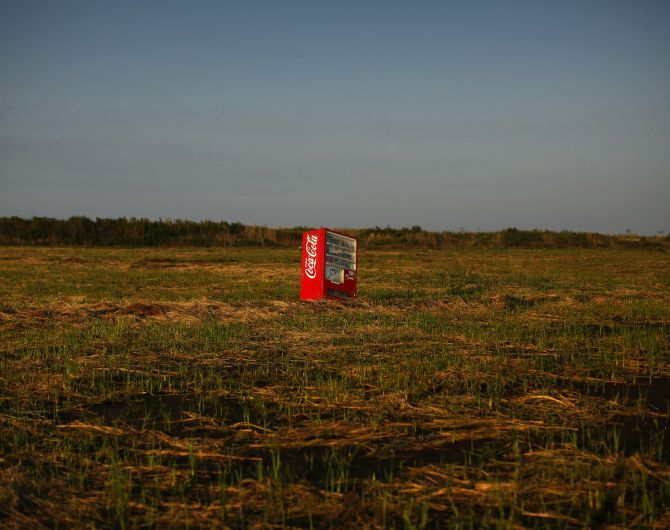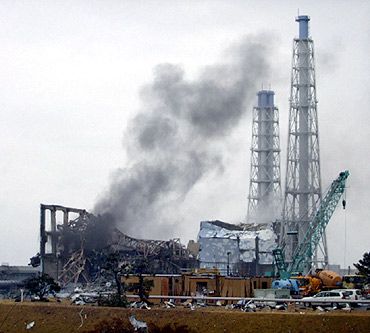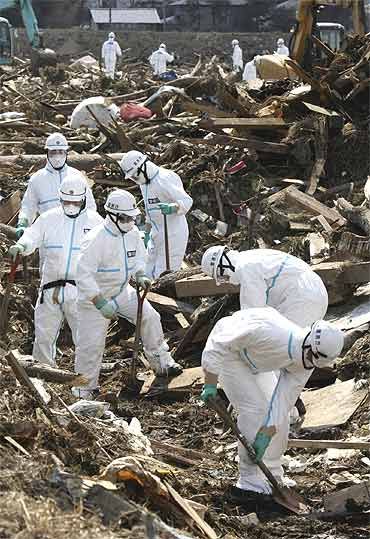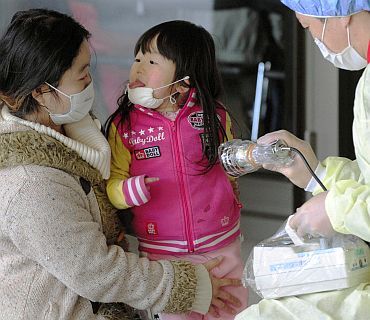'The lessons learnt from the triple disaster have put Japan's energy future on the right path,' notes Dr Rajaram Panda.

On this day, on March 11, 2011 at 2.46 PM, Japan's Tohoku region was struck by the Great East Japan Earthquake of a magnitude of 9, the largest one recorded in Japan's history.
A decade has passed since then, but it never goes out of public memory.
Like the hibakushas, victims of nuclear radiation in 1945 who continue to retain the scar, the Great East Japan Earthquake has left similar victims till now and may be for future too.
What followed was a massive tsunami that led to a nuclear meltdown at the Fukushima nuclear plant.
Over 250,000 people were rendered homeless.
The Japanese know these three as a triple disaster and remember as the Great East Japan Earthquake as they do for the nuclear bombing of Hiroshima and Nagasaki as Hiroshima Day and Nagasaki Day.
I was in Japan on this fateful day on an academic assignment and have first-hand experience of what transpired in quick time disrupting everyone's lives.
The experience was so traumatic that it never gets erased from memory.

As an archipelago, Japan is prone to natural disasters such as earthquakes, torrential rain, typhoons and other calamities almost every year, each leaving with varying levels of destructions.
Used to such calamities, Japanese society has become quite resilient and draws lessons each time to prepare for such eventualities in the future.
About 1,500 earthquakes strike Japan every year.
Minor tremors occur on a nearly daily basis, as I have felt during my many visits to that country.
But big earthquakes are a tragic part of the nation's past.
The anniversary of the Great Kanto Earthquake of 1923 killed more than 100,000 people around Tokyo as the technology used at that time was not advanced and therefore could not prevent the number of deaths.
Modern day buildings constructed with earthquake-resistant technology and other disaster prevention measures have mitigated the casualty to some extent even if the earthquakes are big.
The Kanto Earthquake is remembered now as the national Disaster Prevention Day.
More recently, a 6.8 magnitude earthquake struck the city of Kobe in 1995, killing more than 6,000 people.

Japan has such a large potential for earthquakes and disaster because the nation sits atop four slabs of the Earth's crust, called tectonic plates.
These plates mash and grind together and trigger deadly earthquakes, like the 9 magnitude earthquake of March 11, 2011.
A fault plane is the plane that represents the fracture surface of a fault.
Energy release associated with rapid movement on active faults is the cause of most earthquakes.

Relatively large earthquakes have occurred off the coast of the Tohoku region in cycles of decades.
A big earthquake is predicted in the Kanto 100 years after the 1923 Kanto earthquake.
Japan, therefore, needs to be on its guard to face such a situation if that occurs.
The threat of a huge earthquake in the Nankai Trough stretching along an area off the Pacific Coast from the Tokai to Kyushu regions could alert the central and the local governments to prepare for reducing the number of death and draw up evacuation plans with less loss of time.
In the worst-case scenario, the death toll is estimated at 230,000.
That is a huge number.
Also the world was awakened to the hard truth of nature's fury that can hit any country any time and coping up with such an eventuality led to the emphasis on how to reduce the impact of such disasters in the future.
In the previous big earthquakes such as the Great Hanshin Earthquake of 1995 and Great Kanto Earthquake, almost 80 to 90 per cent of deaths were caused either by collapsed building or burned to death.
Use of modern technology can lessen such damage from future earthquakes.

Though each disaster demanded different response, it might be instructive go know what lessons Japan learnt from the Great Japan Eastern Earthquake of 2011?
In the first place, the 10th anniversary of the disaster is a sombre reminder to reinforce preparations for the future possible such situations, anticipating all possible situations, including the scale and time of occurrence.
Research by seismologists could help predict temblors with a high degree of accuracy.
Two areas have received added priority: a. Focus on realistic disaster prevention and mitigation measures; and b. Reviewing the country's energy policy by reducing dependence on the nuclear energy.
The anti-nuclear sentiment is already deep-rooted among the Japanese people following the experience of Hiroshima and Nagasaki in August 1945 that ended the War.
As regards the first, the government in 2017 started focusing on how to prevent disasters and mitigate casualties such as loss of lives and property.
What policies were directed at devising measures to reduce damage, if not prevent, and how to achieve quick recovery after disasters as those are becoming now frequent?
Since the threat looms large of a possible major earthquake occurring directly beneath the Tokyo metropolitan area as the capital sits right below an active fault line, prevention measures were decided to be directed at reducing damages in urban disasters, such as fire in areas with a high concentration of wooden houses and damage to high-rise buildings.
Quick evacuation also has been prioritised.
If Tokyo is hit and power supplies are disrupted, an estimated 2.5 million people need to be evacuated from high-rise condominium buildings where residents rely on elevators.
The second priority emerged more important than the first for future preparations.
Japan learnt hard lessons.
The nuclear meltdown led to dramatic overhaul in the country's energy policy as all the nuclear reactors, both active and aging, were shutdown.
The role of nuclear energy in the country's energy-mix underwent thorough transformation.
The anti-nuclear sentiment is already deep-rooted among the Japanese people following the experience of Hiroshima and Nagasaki in August 1945 that ended the War.
The experience of nuclear meltdown further strengthened that sentiment.
Pressure also started built up in countries around the world to revisit their nuclear energy policies.

Before the earthquake and tsunami, nuclear energy accounted for almost a quarter of Japan's total energy supplies.
With all reactors in Japan shutdown following the meltdown and amid mounting cry around the world to phase out nuclear as a source of energy, the thrust on developing and depending on renewable energy for the future increased almost overnight.
Fortunately, Japan had learnt hard lessons from the oil shocks of the 1970s and had enough stockpiles to meet the country's surging energy demand.
As a country deficient on domestic energy supply, its dependence on energy imports is always high.
Japan had to develop strategies to see a new path to develop renewable as Japan's energy future.
The importance of renewable energy thus remained no longer on the margins of official debate but took the centre stage.
Renewable has now become an integral part of government policy, corporate strategy and public interests in realising economic and environmental goals.
Since then, alternative energy sources such as wind, solar, geothermal energy, hydro and biomass have assumed greater importance.
Japan too expects to use such sources to enable it to play major roles and become carbon neutral by 2050.

A year before the triple disaster, nuclear accounted for a little over 31 per cent of Japan's total needs whereas renewable sources accounted for only 9.5 % of its electricity mix.
In fiscal 2019, the percentage of renewable had increased to 18 %.
The government expects this percentage to increase 22% to 24% by 2030.
Prime Minister Yoshihide Suga's government intends to further increase the use of offshore wind and hydrogen ammonia.
The government hopes to expand its goal of having wind farms to generate 10 gigawatts of electricity by 2030 and between 30 and 45 gigawatts by 2040.
When such target is achieved, it would have been equivalent to the power generated by between 30 to 45 nuclear reactors.
After stringent safety checks, only nine reactors have been officially approved to restart.
However, as of February 2021 only four were actually operating.
This demonstrates that the transition from the dependence on nuclear to renewable and other safe energy sources could take close to two decades.

Japan's 2050 Green Growth Strategy states that renewable energy will account for 50% to 60% of the energy sources and the remainder to come from nuclear power, thermal power that employs carbon capture and storage technology and hydrogen ammonia.
This path is not without challenges.
Costs and ability of renewable energy suppliers to access the electricity grid are some of them.
The lessons learnt from the triple disaster have put Japan's energy future on the right path.
Dr Rajaram Panda is Senior Fellow-designate at Nehru Memorial Museum and Library, New Delhi, and former ICCR Chair Professor at Reitaku University, Japan.
Feature Presentation: Ashish Narsale/Rediff.com











